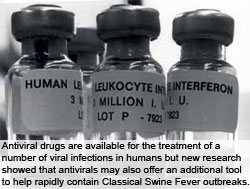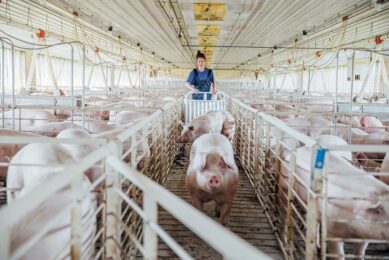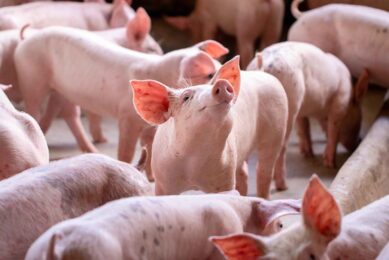Viral inhibitors: An additional tool to control CSF

Since the early 90s, the European Union has adopted a non-vaccination policy against Classical Swine Fever (CSF). This is because of the inability to differentiate between vaccinated and infected animals using live vaccines. In a quest to find a suitable alternative to control the disease, Belgian researchers explored the use of viral inhibitors.
By R. Vrancken, A. Haegeman, J. Neyts and F. Koenen
The prevention of viral diseases in animals has so far relied on vaccination and, especially in livestock, on stamping-out. An alternative for these strategies might be the use of potent inhibitors of the viral replication. Although potent antiviral drugs are available for the treatment of a number of viral infections in humans (i.e. infections with HIV, hepatitis B and C viruses, herpes viruses and influenza virus) its use in veterinary medicine is virtually unexplored. Only for pets, where interferon is used to treat dogs and cats for respectively parvovirosis and feline leukemia, an antiviral treatment is available. Antivirals may be particularly attractive for the control of epizootic diseases where no vaccines are commercially available or where vaccine efficacy is not optimal. This was recently clearly demonstrated for Classical Swine Fever which was used as a model for this novel approach in controlling viral diseases in (farm) animals with viral inhibitors.
Economic important disease
Classical Swine Fever (CSF) has been a threat to the pig industry since the early 19th century and is regarded as one of the most economically important viral infectious diseases of domestic pigs. The disease is caused by the Classical Swine Fever Virus (CSFV) and can affect all members of the Suidae family, i.e. domestic pigs and wild boar. In natural conditions pigs get infected via orally and nasally after direct contact with an infected animal, but the disease may as well be transmitted by swill feeding, contaminated tools, clothes or even by aerosols. Infected animals can display a variety of clinical signs, from subclinical to severe, depending on a number of host (such as age and health status) and virus (such as strain virulence) associated factors. Although the disease is successfully eradicated from many European regions, it remains widespread in many parts of the world.
Current measures for control
Currently two strategies are used to control CSF outbreaks, i.e. vaccination and non-vaccination. Vaccination has proven to be successful to eradicate and/or to control CSF in domestic pigs. Effective live vaccines, consisting of an attenuated virus strain (such as the C-strain and Thiveral), exist and are still widely used in South America and Asia. This strategy was used in European domestic pig populations but was stopped due to the inability to differentiate between vaccinated and infected animals (DIVA) using these live vaccines. As freedom of CSFV is still demonstrated by freedom of CSFV antibodies in the animals, vaccination may severely disrupt international trade. Therefore, the use of these vaccines was banned in the EU and a non-vaccination policy was adopted in the early 90s. As a consequence, the European pig population again became vulnerable to CSFV. Although CSFV is eradicated in domestic pigs in the EU, the disease still circulates in wild boar populations. This is important because in certain regions there is a close contact between wild life and domestic pigs, making re-introduction of CSFV into the domestic pig population a realistic threat.
Currently, a stamping-out and pre-emptive eradication strategy is applied in case of an outbreak in domestic pigs. The spread of the virus is controlled and reduced by eliminating all infected animals and all animals in neighbourhood farms which were possibly in contact with infected animals. This rather radical strategy results in a massive destruction of animals, often healthy, which was illustrated by the last epizootic in the Netherlands in ’97-’98. Stamping-out and pre-emptive culling resulted in the slaughter of over 1.5 million animals, of which 1.1 million animals were culled pre-emptively. The destruction of vast number of animals with its financial and social burden is increasingly criticised by the public opinion and additional or alternative methods are demanded.
A possible alternative using a vaccination strategy without economical restraints (i.e. allowing DIVA) was thought to be found in a sub-unit vaccine consisting of the viral protein E2. This type of vaccine was until recently commercially available, but the use was severely hampered by the variable efficacy and the lack of accuracy of the accompanying diagnostic methods.
Viral inhibitors
Can viral inhibitors be an alternative tool in disease control? This question was raised in an attempt to fill the gap in CSF control and to offer a more ethical approach than the current strategy.
A joint project was therefore launched in 2004 by the Veterinary and Agrochemical Research Centre in Ukkel (VAR) and the Rega Institute for Medical Research of the University of Leuven in order to investigate this problem.
This project merged the expertises in veterinary (VAR) and human virology (Rega Institute) and resulted in the selection of a class of compounds with selective antiviral activity against the bovine viral diarrhoea virus, a virus belonging to the same virus family as CSFV. This compound class was further evaluated against CSFV and led to the identification of BPIP (5-[(4-Bromophenyl)methyl]-2-phenyl-5H-imidazo[4,5-c]pyridine) as a representative molecule with potent in vitro antiviral activity.
Reduced virus replication
Following the identification of BPIP, an early and yet to be optimised lead compound, the next objective was to investigate whether treatment with this viral inhibitor was able to protect the host from the infection. Therefore, a group of eight pigs was administered BPIP for a period of 15 days at a dose of 75 mg/kg/day by mixing the viral inhibitor with pig feed. On the first day of the treatment all pigs were infected with CSFV and the presence of the virus in the blood was analysed every other, or every three, days. For comparison, a group of infected, but untreated animals was included in this study as well. When the results of both groups were compared, a marked difference could be observed (Figure 2). All treated animals survived infection whereas two untreated animals had to be euthanised for ethical reasons. The period where infectious virus could be detected in animals that were treated with BPIP was markedly shorter than in the animals that were untreated. Not only was this period (of viraemia) shorter, but one animal remained negative for CSFV during the whole experiment. In addition, when we analysed the infectious virus titre at day seven after the infection, we observed a highly significant reduction of virus in BPIP-treated animals (on average 3 log10).
Reduced spreading of CSFV
In controlling disease outbreaks, one of the crucial factors is the ability to reduce the spread of the virus and contain the initial outbreak site. Therefore, we evaluated the potential of antiviral therapy in reducing virus transmission (Figure 3). This was done by placing four untreated/uninfected animals (sentinels) in contact with the untreated/infected and BPIP-treated/infected animals. Again the presence of the virus in the blood was monitored in all the animals in contact with the infected ones. This experiment revealed that although animals were in close contact, the spread of the virus towards the animals in contact with the BPIP-treated animals was markedly reduced. Only in one animal in contact with the BPIP-treated animals virus could be detected originating from the BPIP-treated animals. The second animal that tested positive was probably the result of a secondary infection from the contact with an earlier infected pig. In contrast, all the animals in contact with the untreated/infected became positive, indicating significant virus transmission. With this study a clear proof-of-concept was achieved, proving that a treatment with a virus inhibitor such as BPIP can significantly reduce the infection of CSFV in pigs. Considering the tendency towards the reduction of virus transmission to untreated animals that was shown, our study strongly suggests that viral inhibitors may be developed as an additional tool for the containment and the eradication of epizootic diseases, such as CSF.
Use in ring treatment
A general approach could be used to apply a viral inhibitor as a “ring-treatment” around the source of the infection as a prophylaxis, making them less susceptible to the infection. All animals within this perimeter would also receive treatment to reduce the spread of the infection from the potentially infected animals to the uninfected animals. If such a ring-treatment is applied, two scenarios could be distinguished. A treat-to-kill scenario aims for the urgent reduction of the infectious pressure. Although this scenario implicates the destruction of all treated animals (diseased or not), the almost instant protective effect of an antiviral means that a quick intervention with the viral inhibitor will significantly reduce the chance of virus spread whereby the infected area remains smaller, meaning fewer animals will be affected and killed. This strategy might as well be integrated in the currently used stamping-out and pre-emptive culling strategy. Although a treat-to-kill scenario may result in a significant decrease of the number of animals being slaughtered, it may in analogy with pre-emptive culling, not be accepted by the public. A treat-to-live scenario is of course the ultimate goal of an antiviral treatment, where meat from treated, uninfected and seronegative animals may still enter the human food chain. To achieve this however, additional thorough and stringent studies (drug residues, environmental impact, etc.) have to be carried out to guarantee the health of the consumer. Using this strategy in case of an outbreak, a national or supranational coordination should be put in place for the distribution of the viral inhibitor to guarantee a controlled and specific treatment. By simply using a mixture of viral inhibitor and feed (as used in this study), an antiviral treatment could be set up relatively quickly and be sent to the afflicted area. A quick response and the almost immediate protection provided by the viral inhibitor would stabilise the epidemic situation. This means that, whether a “treat-to-kill” or “treat-to-live” scenario is chosen, this approach would result in a drastic decrease of the number of animals that need to be slaughtered and thereby limiting the economic and social impact of a CSF outbreak.
Tool to contain outbreaks
We provided for the first time a proof-of-concept that a specific and potent inhibitor of CSFV can be employed to rapidly reduce viral replication in infected pigs, thereby also reducing the likelihood of uninfected bystander pigs becoming infected. It should be noted that BPIP is only a first lead compound of this class of molecules. Within this class novel analogues are being developed that are yet more potent and that have a good/excellent oral bioavailability (i.e. efficient uptake of the drug from feed). Once available, such potent inhibitors may offer an additional tool to help rapidly contain outbreaks. Finally, a similar strategy could be developed to contain outbreaks with other epizootic viral diseases such as Foot-and-Mouth disease or the African Swine Fever.











